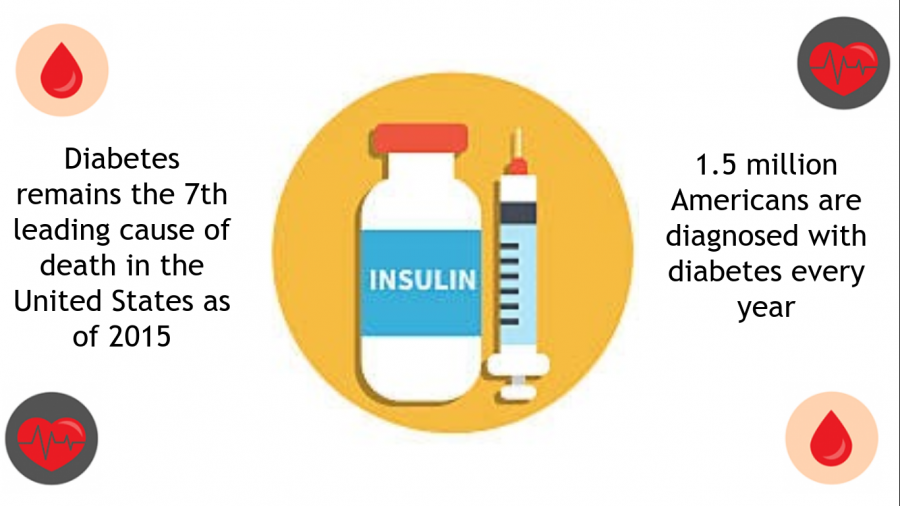Why isn’t insulin, a life-saving drug, affordable for all?
Insulin, a necessary drug to manage diabetes, is now too costly for many to afford. Statistics are from the ADA.
January 23, 2020
On a normal morning, many teens wake. . . and hit the snooze button. . . again. They brush their teeth and are out the door, but for sophomore Ashley Alt, mornings look a little different. She wakes up to check her blood sugar. Next, she carefully plans her carb count for breakfast and makes sure she will have healthy insulin levels for the day. This is what a typical morning looks like for a diabetic.
Diabetes Type 1 is a lifelong battle of finding the balance between medicine and food. Some people with diabetes cannot go several hours without a shot of insulin to keep them alive. Insulin is a hormone naturally produced in the body to break down glucose (sugar). It is a necessity for a long life, but with the rapidly increasing prices of insulin, diabetics are having to choose between insulin and . . .well . . . life.
“Some days it’s easy to forget about the consequences that lie ahead if you do not do everything right. If I take too much insulin, I could go into hypoglycemia which is extremely low blood sugar. . . and die. Or I could go into hyperglycemia which is extremely high blood sugar. . . and go into a coma. One day I forgot my pump at home, and I was without insulin for only 1 ½ hours. That was one of the scariest times ever. I was dizzy, sweating, and nauseous all because I was without insulin for a little over an hour. The fact that so many Americans go hours, or even days, without insulin is a gut wrenching feeling,” said Alt.
Living a normal life should not be a concern when thinking about the price of insulin. For the 30 million Americans who live with diabetes, 29.3 million of those pay outrageous prices for monthly insulin. Most diabetics that have a good insurance plan pay a minimum of $300 for a vial, while diabetics without insurance can pay up to $800 per vial. For Alt, the vial lasts a little less than 30 days. According to the American Diabetes Association (ADA) an average American with diabetes can pay up to $16,000 a year for insulin, medical bills, and supplies if they do not have insurance.
“There are local support groups around this area that do help many people. Currently, I am not enrolled in a support group. I have heard of groups trying to give discounts, but they are rare,” said Alt.
Many people overlook the high prices of essential medicines because they are perfectly healthy. Others with diabetes ration their insulin and go hours, even days without insulin because they cannot afford the costs. This can lead to complications, including death. This is not an optional drug that people can skip.
The United States has made improvements on the rising medical bills. The ADA provides financial aid to those in great need. There are many support groups around Maryland that provide counseling and assistance to those with diabetes. Locally, Frederick Memorial HealthCare System has a support group and offers nutrition counseling to those searching for help.
“Coupon cards, savings cards, and manufacturer coupons are offered to many patients when they ask for financial assistance. There are many handouts in diabetes offices for people to take to get discounts on their insulin,” said an employee for the Frederick Health Diabetes and Nutrition Center. However, those with diabetes often do not have access to these services, coupons, and online benefits without help from professionals.
Maryland lawmakers have taken the first step toward affordable drug prices. They have established a work group but are a long way away from passing laws to help. They have acknowledged the outrageous prices and, hopefully, by 2022 some sort of law will be put into place on how to regulate the prices.
The drug insulin is controlled by three main companies, Eli Lilly, Novo Nordisk and Sanofi. These three companies act as a canopy when setting the prices to sell insulin to smaller drug companies. These companies then pocket the profit of this necessary drug. They are taking advantage of the vulnerability of diabetics. Insulin is a relatively inexpensive drug but they are asking for way more money. There is no clear reason for the high prices, except for greed.
“Currently, I am not worried about the prices because I am on a strong plan with benefits and support, but in the future, that could change. Which is a scary feeling,” said Alt. According to the Affordable Care Act (ACA), all young people can be on their parents’ medical insurance until age 26. After that, Alt will need a job with good benefits in order to pay for her insulin.
Many people who live normal lives think diabetes is nothing major. They overlook the hidden consequences that come with not taking insulin. This should not be something that is overlooked, and with the prices soaring, the concern seems to be diminishing. A change is needed to make for a safer, healthier future for people in the diabetes community.






